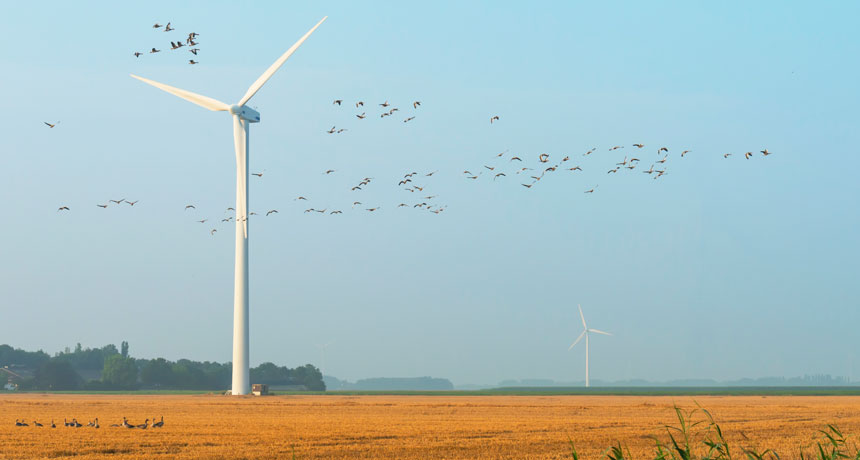Where did that turbine blade get smacked?
A new technique helps inspectors and repair crews calculate where an object struck a spinning blade

Bird collisions can damage turbine blades. A teen now shows how to narrow the search for such damage on helicopter or wind-turbine blades.
iStockphoto / photonaj
By Sid Perkins
PHOENIX, Ariz. — Each year in the United States alone, more than 100,000 birds die from flying into wind turbines. But those turbine blades can suffer damage, too. Now, a teen has figured out a way to narrow down the search for damaged spots on whirling blades — even when no one saw the impact occur.
And wind turbines aren’t the only whirling blades to suffer damage from impacts. Birds and bats also collide with the propellers of many aircraft. Then there is all that debris that helicopters can kick up as they come in for a landing. These rocks and more can whack blades on the chopper’s rotor, notes Jonathan Yu. This 17-year-old attends Great Mills High School in Maryland.

So this teen investigated how to narrow any search for impact damage. He described his solution here, last week, at the Intel International Science and Engineering Fair. Created by Society for Science & the Public and sponsored by Intel, this year’s competition brought together more than 1,750 students from 75 countries. (SSP also publishes Science News for Students.)
Jonathan’s first idea was to place two sensors on each whirling blade. One might be located near its base and the other near the tip. These sensors would detect vibrations created as some object slammed into the blade. By measuring when the first vibrations reached each sensor, he would be able to estimate where the impact had occurred. If the sensor near the tip felt the vibrations first, the impact would have happened on the outer half of the blade, for example. (Geologists use the same sort of analysis from networks of seismometers to pinpoint where earthquakes occurred.)
But when Jonathan ran tests on his scale models of helicopter blades, he noticed something interesting. He could figure out where the impact had occurred by simply analyzing the shapes and sizes of the vibrations caused by an impact — and not their timing. This meant that he no longer needed two sensors. One would do.
The best spot to place such a sensor might be near the base of a blade, where it attaches to the rotor hub, Jonathan says. On a helicopter, signals from the sensor could be sent wirelessly to a recorder on the aircraft itself. Or, those signals could be sent on to instruments on the ground. In either case, the data could be preserved and analyzed in case a blade is struck and damaged. Also, in the event of an accident, such data could help tell whether a blade was damaged before a crash as opposed to during the crash.
These data also could be used to recognize damage on a blade even before it’s inspected. If the blade begins to vibrate differently from when it was new, Jonathan says, this might signal some type of impact damage has occurred.
Power Words
(for more about Power Words, click here)
debris Scattered fragments, typically of trash or of something that has been destroyed. Space debris, for instance, includes the wreckage of defunct satellites and spacecraft.
flight data recorder An electronic device used on aircraft to record the signals sent to or received by any of the electronic systems on an aircraft. Complex FDRs, which record more signals than simple ones, often store the voices of pilots and other people in a cockpit. Investigators may use such data to unravel what led up to an accident, for example.
seismometer (also known as a seismograph) An instrument that detects and measures tremors (known as seismic waves) as they pass through Earth.
sensor A device that picks up information on physical or chemical conditions — such as temperature, barometric pressure, salinity, humidity, pH, light intensity or radiation — and stores or broadcasts that information. Scientists and engineers often rely on sensors to inform them of conditions that may change over time or that exist far from where a researcher can measure them directly.
Society for Science and the Public, or SSP. A nonprofit organization created in 1921 and based in Washington, D.C. Since its founding, SSP has been not only promoting public engagement in scientific research, but also the public understanding of science. It created and continues to run three renowed science competitions: the Science Talent Search (begun in 1942), the Intel International Science & Engineering Fair (launched in 1950) and Broadcom MASTERS (created in 2010). SSP also publishes award-winning journalism: in Science News (launched in 1922) and Science News for Students (created in 2003). Those magazines also host a series of blogs (including Eureka! Lab).
vibrate To rhythmically shake or to move continuously and rapidly back and forth.







